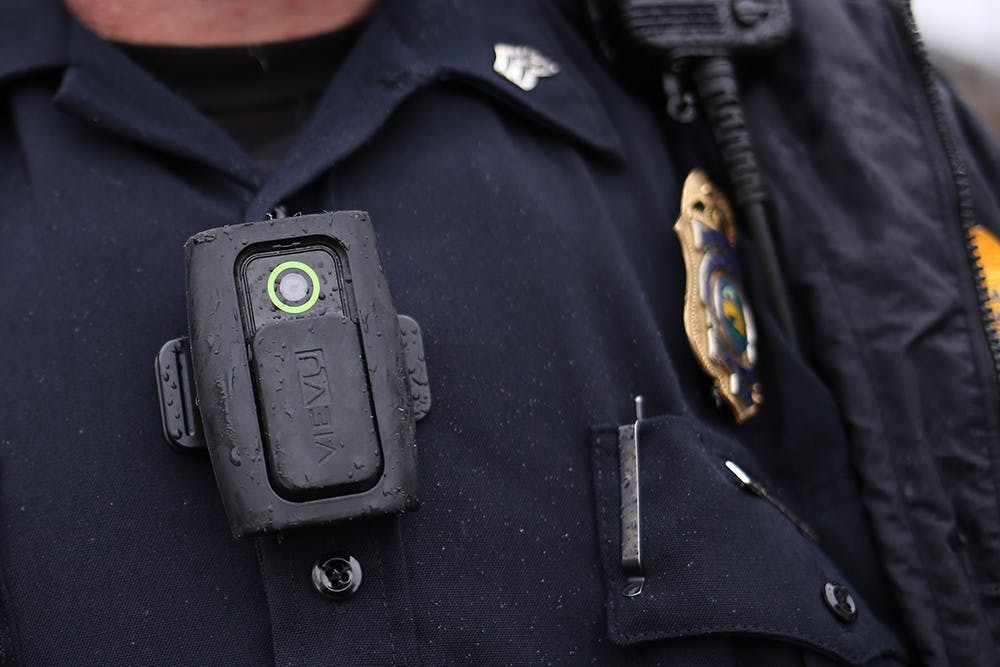Body cameras for police officers have grown in use since the incident in Ferguson, Missouri, when an unarmed black teenager named Michael Brown was shot and killed by Darren Wilson, a Ferguson Police officer.
But the effectiveness of body cameras in comparison to their cost is still being evaluated by both police and civilians.
During the grand jury proceedings, the jury chose not to indict Wilson for shooting Brown. While he was not indicted, the proceedings found FPD had engaged in numerous constitutional violations while policing and that the whole system needed to be overhauled.
After those events, body cameras began to be more widely used by police departments. The Bloomington Police Department actually began using body cameras a year prior to Ferguson and has since acquired more cameras for all of its officers.
BPD Capt. Steve Kellams said while many officers were nervous about putting them on at first, many of those same officers will not leave the department anymore without having one on them.
The body cameras are designed to increase the level of accountability between both the police and the public. For the public, the cameras are meant to reassure them that the actions of police will be recorded. And for police, they are meant to be reassuring that their perspective of events will be preserved, Kellams said.
With body cameras, the perspective of the officers is now available and can help corroborate or contrast with other recordings.
Souleymane Diallo and Daja Palmer from the Black Student Union at IU disagreed with the idea that the cameras provide additional accountability for officers, and cited examples of when footage has failed to curb police violence and indict those caught on camera harming citizens.
“It’s not going to prevent anything.” Palmer said. “Police do what they please.”
[What other types of technology is BPD embracing?]
Dialla said while a great deal of violence has already been recorded and shared to the public, the cameras and the footage have not changed anything in regards to police and civilian interactions.
Kellams also said it is important to note that the cameras do not provide all the information in a situation.
“They never provide all the facts,” Kellams said.
The cameras are also expensive to maintain and to extract video from if requested by the public. Indiana Public Access laws require that these videos be made available to the public for a fee of $150. Some critics of the fee say it limits who can access the footage, but Kellams provided an example of why the fee is there.
Kellams said if three officers are working a traffic accident that takes three hours to clear up and someone wants the footage for that accident, it is not just a simple matter of turning over the video.
Certain pieces of information cannot be revealed, such as social security numbers or names of victims in more serious crimes, and all of that has to be scrubbed clean. Kellams also said that includes not just one officer’s camera footage, but all three, which is a total of nine hours of footage.
BPD officers go through every inch of that footage in order to scrub and organize it, and with the limited manpower of BPD, Kellams said the $150 fee is there just to pay officers to go through that video.
“We don’t have the manpower to handle it,” Kellams said.
The storage space for that footage is also hard to come by, and Kellams said when the video is requested, it has to be kept for 99 years. Those requests mean that the video has to be maintained in a safe storage place — either on disc or possibly cloud-based storage — for a long period of time.
The cost has become so great that Indianapolis Metropolitan Police Department has stopped using its body cameras, Kellams said. The cost is something BPD is also considering as it plans how it is going to move forward with storage for the video footage.
Dialla said while he was uncertain on whether or not it has been helpful so far, he hopes it will provide extra accountability for officers and help safeguard the public, especially post-Ferguson.
[In early 2015, BPD said the cameras were beneficial. What happened?]
“If it can do something, I’m for it,” Diallo said.
While figuring out the logistics of paying for body cameras is playing a huge factor, Kellams noted just how beneficial it is to BPD officers, even if it does not provide all the facts. On the other side of the issue, people like Diallo and Palmer worry the extra footage and visibility will not be enough to curb future violence.
“Is it everything? No, but it’s a lot more than anything we had before,” Kellams said.






